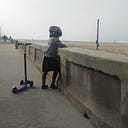Smaller LA-Area Cities and Transportation in 4 Minutes
This article offers a brief glimpse at how smaller cities and unincorporated areas in LA County handle transportation. It is part of a series that provides short guides to different governmental transportation organizations in LA and CA.
Each of the 88 cities and the unincorporated areas of LA County does transportation in its own particular way.
LA city is the biggest city — at 4 million people it is by far the biggest city in LA County — and it splits transportation functions into large departments of hired staff.
But smaller cities do things differently, as do the unincorporated areas. Despite the inherent difficulty in summarizing the wide spectrum of approaches, it is worth attempting a general overview of how these other cities and unincorporated areas handle transportation.
Reminder: LA County has a population of just over 10 million people, and the big map below to the right breaks down the entire land area of LA county into three categories:
- The red part of the map is the city of Los Angeles. It is the biggest city in LA county, both in area and population. Four million people live in Los Angeles, making it the second biggest city in the US.
- The grey parts are all the other independent cities in LA County- Long Beach, Beverly Hills, Compton, Pasadena, etc. All together, these cities hold about five million people.
- The white parts are the many unincorporated areas of LA county They make up 65% of the land area and hold about one million people. Much of this area is unsettled mountains and plains, but if you look carefully you can see there are many pockets of urbanized land that resemble small cities.
(Note- I go into this topic of LA jurisdictions in more in depth in an article here.)
Smaller Cities
In contrast to the city of LA, which divides transportation planning/design/construction/maintenance into large departments, most smaller cities in LA County house those functions in a single Public Works department. If the city is large enough to have a planning department then the “transportation planning” function might reside there, but it just as easily might stay within Public Works.
Either way, in these cities you can usually find all transportation staff in one building, and perhaps even on one floor.
Large “smaller” cities like Glendale and Long Beach have robust in-house transportation staff. Small “smaller” cities tend to rely more on outsourcing specialized work to private transportation planning and engineering firms, since the work volume doesn’t merit hiring full-time staff.
City staff at these smaller cities might work with the community to conceive a transportation project, but they would then put it out to bid to see which firm would like to implement the project. Once a firm is selected, city staff would continue to manage that firm’s work until the project is completed.
Some cities contract with firms for their city traffic engineer or their transportation planning functions. Even cities that are large enough to hire their own staff for these core functions will still hire private firms for special projects and long range planning efforts. In any case, the consultant role is most often to provide subject expertise and staff capacity in roughly equal measure.
Contracting with LADPW
Rather than hiring in-house staff or using private consulting firms, another option is for a smaller city is to simply contract with the LA County Department of Public Works (LADPW).
Just as smaller cities have the choice of operating their own library system vs. contracting with LA County to operate libraries in their city, the same choice exists for transportation: a city can hire its own transportation staff or consultants, or it can contract with LA County and the substantial resources offered by LADPW.
The unincorporated areas of LA County have no choice in the matter of transportation. As jurisdictions under the control of LA County, all of their transportation needs are performed by LADPW.
There is always a trade-off in doing transportation in-house vs. contracting with LADPW. Some cities see the autonomy and localized knowledge that comes with having in-house transpiration staff as worth paying for, while others prefer the cost-savings and utility of working with LADPW.
On a sidenote: this same principle of “in-house” vs. “contracting with LA County” applies to bus systems. Cities can work with LA Metro and its massive bus system for their public transit needs, and almost all do in some capacity. But many cities also operate their own public transit systems, like Santa Monica (Big Blue Bus), Montebello (Montebello Bus Lines), Long Beach (Long Beach Transit), and others. Foothill Transit is a multi-city transit system that serves 22 cities in the San Gabriel and Pomona Valleys within LA County, and it operates independently of LA Metro.
There are many ways for smaller cities to fulfill their transportation functions, and the approach for each city depends on its size, financial resources, and how it perceives the costs and benefits of hiring staff, using consultants, and/or working with LADPW.
Go here for the main page of this transportation series.
